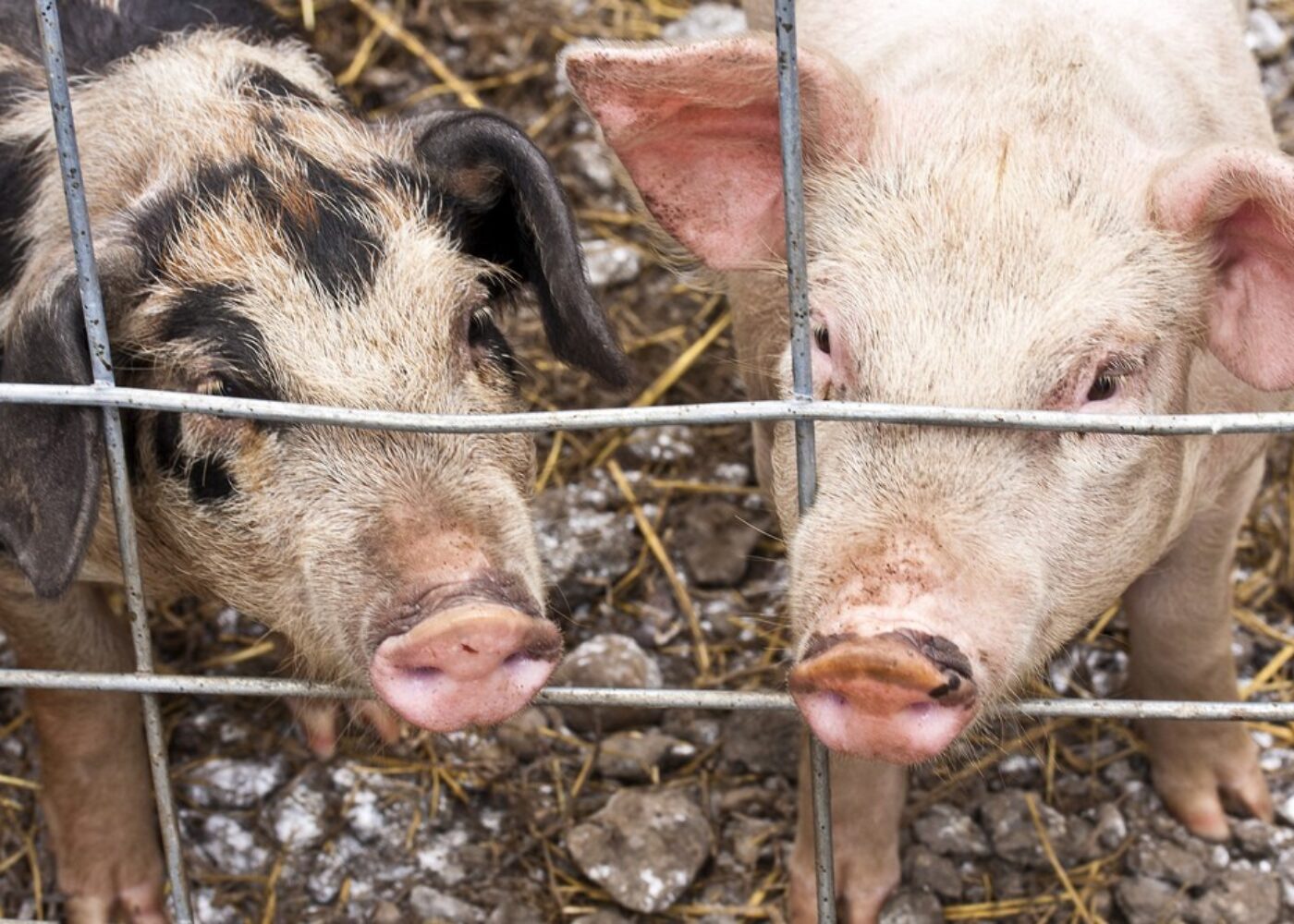GMOs: A Pig Feeding Trial Exposes Problems and “He Said, She Said” Science

A just-released study shows that animals found in the US food supply are harmed by the consumption of feed containing genetically modified corn and soy.
It’s enough to make anyone paying attention to the genetically modified food debate sit up and take notice.
And it did, but it also brought another issue to light: the growing influence that funding ties are having over scientific studies and the journals they are published in.
The research results were striking, showing that the weight of the uterus in pigs fed genetically modified foods was on average 25% higher than in the control group of pigs. Also, the level of severe inflammation in stomachs was markedly higher in pigs fed on the genetically modified food diet. These animals were 2.6 times more likely to get severe stomach inflammation than control pigs. While 22% of male pigs and 42% of female pigs on the genetically modified food diet had this condition, when these pigs were compared to pigs on the control diet, it was found that male pigs were actually more strongly affected. While female pigs were 2.2 times more likely to get severe stomach inflammation when on the GM diet, males were 4 times more likely.
According to the researchers, these findings are both biologically significant and statistically significant. The research was conducted by collaborating investigators from two continents and published in the peer-reviewed Journal of Organic Systems.
Yes, the Journal of Organic Systems. A look at the journal’s sponsors shows that the Organic Federation of Australia sponsors the journal.
Why is this important? Journals and their editors have a lot of power in science – power that provides opportunities for abuse. The life science industry knows this, and has increasingly moved to influence and control science publishing. In 2009, the scientific publishing giant Elsevier was found to have invented an entire medical journal, complete with editorial board, in order to publish papers promoting the products of the pharmaceutical manufacturer Merck.
And in early 2013 the scientific journal of Food and Chemical Toxicology editorial board acquired a new “Associate Editor for biotechnology”, Richard E. Goodman. According to Independent Science News, Richard E. Goodman is professor at the Food Allergy Research and Resource Program, University of Nebraska. But he is also a former Monsanto employee, the company whose products were recently challenged in a scientific study published in this journal, who worked for the company between 1997 and 2004. While at Monsanto he assessed the allergenicity of the company’s GM crops and published papers on its behalf on allergenicity and safety issues relating to GM food (Goodman and Leach 2004).
So with eyes wide open to how these journals are being used, what did the pig study in the Organic journal find? The feeding study lasted more than five months and was conducted in the US. 168 newly-weaned pigs in a commercial piggery were fed either a typical diet incorporating GM soy and corn (2), or else (in the control group) an equivalent non-GM diet. The pigs were reared under identical housing and feeding conditions. They were slaughtered over 5 months later, at their usual slaughter age, after eating the diets for their entire commercial lifespan. They were then autopsied by qualified veterinarians who worked “blind” – they were not informed which pigs were fed on the GM diet and which were from the control group. The research was undertaken because farmers have for some years been reporting reproductive and digestive problems in pigs fed on a diet containing GM soy and corn (3).
Farmers have seen a reduced ability to conceive and higher rates of miscarriage in piggeries where sows have been fed on a GM diet, and a reduction in the number of piglets born if boars were used for conception rather than artificial insemination. There is also evidence of a higher rates of intestinal problems in pigs fed a GM diet, including inflammation of the stomach and small intestine, stomach ulcers, a thinning of intestinal walls and an increase in haemorrhagic bowel disease, where a pig can rapidly “bleed-out” from its bowel and die. The new study lends scientific credibility to anecdotal evidence from farmers and veterinarians, who have for some years reported reproductive and digestive problems in pigs fed on a diet containing GM soy and corn. The study seemed significant for four reasons:
- Results were found in real on-farm conditions, not in a laboratory
- Pigs were used and pigs end up in our food supply.
- Pigs have a similar digestive system to people
- The animals were fed a mixture of crops that contained three genetically modified genes and genetically modified proteins, relatively new to the food supply.
No food regulator anywhere in the world requires a safety assessment for the possible toxic effects of mixtures. Regulators simply assume that they can’t happen.
In other words, we are eating these foods in combination without an understanding of what their synergistic toxicity might be.
The study also aimed to address the concern of farmers who had found increased production costs and escalating antibiotic use when feeding genetically modified food crops to their animals.
But if these foods were introduced into our food supply in the 1990s, why are we only just now conducting the studies? Shouldn’t they have been conducted before these products came to market? And what is the concern?
According to Michael Hansen, PhD, a senior scientist at the Consumers Union, in testimony on H1936, an Act relative to Genetically Engineered Food; H2037, an Act to establish guidelines for genetically engineered food; and H2093, an Act relative to the labeling of food before the Joint Committee on Public Health in Boston, MA, said, “There is global agreement that genetic engineering is different than conventional breeding and that safety assessments should be completed for all GE foods prior to marketing. The human safety problems that may arise include introduction of new allergens or increased levels of naturally occurring allergens, of plant toxins, and changes in nutrition. There may also be unintended effects.”
So how did the US, the FDA, allow these ingredients into our food supply while the rest of the world exercised such precaution? And while correlation is not causation, does it explain the 400% increase we have seen in the number of children with allergies?
Without labels on these foods, there is no way to know.
The United States, unlike all other developed countries, does not require safety testing for genetically modified plants now found in our food supply (although it does require an assessment for genetically modified animals). The US Food and Drug Administration’s (FDA) original policy on genetically engineered (or GM, for genetically modified) plants, developed more than twenty years ago,[1] says that companies may go through a “voluntary safety consultation.” But, in the end, FDA says it is up to the companies to determine safety of any GE food. To date, there have been some 97 “voluntary safety consultations.”
But that was twenty years ago. So what has happened lately?
It turns out that just last June, the American Medical Association’s House on Delegates voted to change its policy on “bioengineered” foods to one that states: “Our AMA supports mandatory pre-market systematic safety assessments of bioengineered foods and encourages: (a) development and validation of additional techniques for the detection and/or assessment of unintended effects; (b) continued use of methods to detect substantive changes in nutrient or toxicant levels in bioengineered foods as part of a substantial equivalence evaluation; (c) development and use of alternative transformation technologies to avoid utilization of antibiotic resistance markers that code for clinically relevant antibiotics, where feasible; and (d) that priority should be given to basic research in food allergenicity to support the development of improved methods for identifying potential allergens.”[2]
According to Hansen’s testimony, one big problem with safety assessments of genetically modified plants now found in our food supply is that there have been virtually no long-term animal feeding studies, with most feeding studies being of 90 days or shorter. A carefully designed meta-analysis of 19 published studies involving mammals fed this new, genetically modified corn or soy found damage in the kidney, liver and bone marrow, which could be potential indicators for the onset of chronic diseases.[3] However, no animal tests are obligatory for any of the genetically modified plants now found in our food supply cultivated on a large scale in the US.
Do other countries do it this way? Or are we the only ones who take the approach: Shoot first, ask questions later?
It looks like we are one of the only developed countries to do it this way, as over 60 countries around the world either banned or labeled these ingredients in the food supply so that consumers can make an informed choice.
Both the French Food Safety Agency (ANSES) and the European Food Safety Authority (EFSA) have concluded that such long-term safety assessment should be done on genetically modified foods.
So where are those studies? A long-term (two year) feeding study published in October, 2012 found that females rats fed the genetically modified corn died 2-3 times more quickly, and developed mammary tumors more often than controls who ate non-GE corn, while male rats fed the GE corn have liver and kidney problems at higher rate than controls, and more large tumors than rats fed non-GE corn.[4]
The study was terrible PR for the chemical and biotech industries whose shareholders rely on these products to drive profitability and was quickly criticized by the scientific community for the way in which the study was conducted. The design of the study had flaws, but perhaps it’s most significant contribution to this dialogue was that it raised the awareness of how few long-term independent studies have been conducted.
The result? It had countries around the world calling for more independent studies and science.
With the news of the US pig study, now we have another one.
The sample size was not small. This one involved US pigs fed a combination of genetically modified corn and genetically modified soy, fed to animals in our food supply and used in our processed foods, has found evidence of adverse health effects. This study involved a large sample size (168 pigs) of pigs raised in a commercial US piggery, and fed commercially available soy and corn for 22.7 weeks (the normal lifespan of commercial pig from weaning to slaughter) was designed “to compare the effects of eating either a mixed genetically modified soy and genetically modified corn diet, or an equivalent diet with non- genetically modified ingredients.”[5] The study found that the uteri of genetically modified food-fed pigs was significantly larger (weighed 25% more) than those non- genetically modified food-fed pigs. In addition, the rate of severe stomach inflammation was more than 2.5-fold higher, on average, for genetically modified food -fed pigs compared to non- genetically modified food -fed pigs (32% vs 12%, respectively).
It hit the males harder. For male pigs, the rate of severe stomach inflammation was four times higher for genetically modified food -fed males to non- genetically modified food fed males, and for females, the rate was more than 2-fold higher. As the authors conclude “The results indicate that it would be prudent for genetically modified crops that are destined for human food and animal feed, including stacked genetically modified crops, to undergo long-term animal feeding studies preferably before commercial planting, particularly for toxicological and reproductive effects.”[6]
You would think that this had already happened before such widespread introduction into the US food supply without so much as a label. But it hasn’t, so scientists here in the US, as well as farmers, join scientists around the world calling for more independent, long-term studies.
And we need them, because a further look into this study by Mark Lynas, a climate change author who recently became an advocate for these products suggests that “if you look at the data they present (and the data presentation is at least a step better than Seralini) there are obvious problems. Clearly all the animals were in very poor health – weaner mortality is reported as 13% and 14% in GM-fed and non-GM fed groups, which they claim is “within expected rates for US commercial piggeries”, a vague statement intended to justify what seem to have been inadequate husbandry standards.
This picture is even more stark in the data presented in Table 3. 15% of non-GM fed pigs had heart abnormalities, while only 6% of GM-fed pigs did so.
He highlights that close to 60% of both sets of pigs were suffering from pneumonia at the time of slaughter, calling the study “propaganda dressed up as science.”
The problem is that this is increasingly the case on both sides of the GMO aisle, with conflicts of interests on both sides of the issue.
There is virtually no independent safety testing of these crops in the US due to intellectual property right problems. When farmers buy genetically modified seed in the US (seeds that have been hardwired to withstand increasing doses of the chemicals sold by the company engineering them), they invariably must sign a product stewardship agreement which forbids them from giving such seeds to researchers.[7] Since researchers must get permission from the biotech companies before they can do research, the result is a scarcity of independent research. Scientists have even been threatened with legal action if they revealed information obtained via freedom-of-information.[8]
In early 2009 26 public sector scientists in the US took the unprecedented step of writing to the US Environmental Protection Agency (EPA) protesting that “as a result of restricted access, no truly independent research can be legally conducted on many critical questions regarding the technology.”[9] As a result, the editors of Scientific American published a perspective stating that “we also believe food safety and environmental protection depend on making plant products available to regular scientific scrutiny. Agricultural technology companies should therefore immediately remove the restriction on research from their end-user agreements.” We concur and believe that only truly independent safety tests will give us an answer about the safety of genetically modified foods. In the meantime, it’s crucial that genetically modified foods be labeled, so that if people experience negative effects, they and their doctors can identify them.
Correlation is not causation, but with the skyrocketing rates of food allergies now seen in the US population, studies showing an increased risk of developing allergies after moving to the United States and the fact that few independent, long-term studies have been conducted due to the intellectual property protections enjoyed by these companies, it’s not only consumers who have a basic right to know what they are eating but parents who also have a basic right to know what is in the foods they are feeding their children.
To learn how to get involved with the labeling of genetically engineered foods in the United States, please visit Just Label It.






